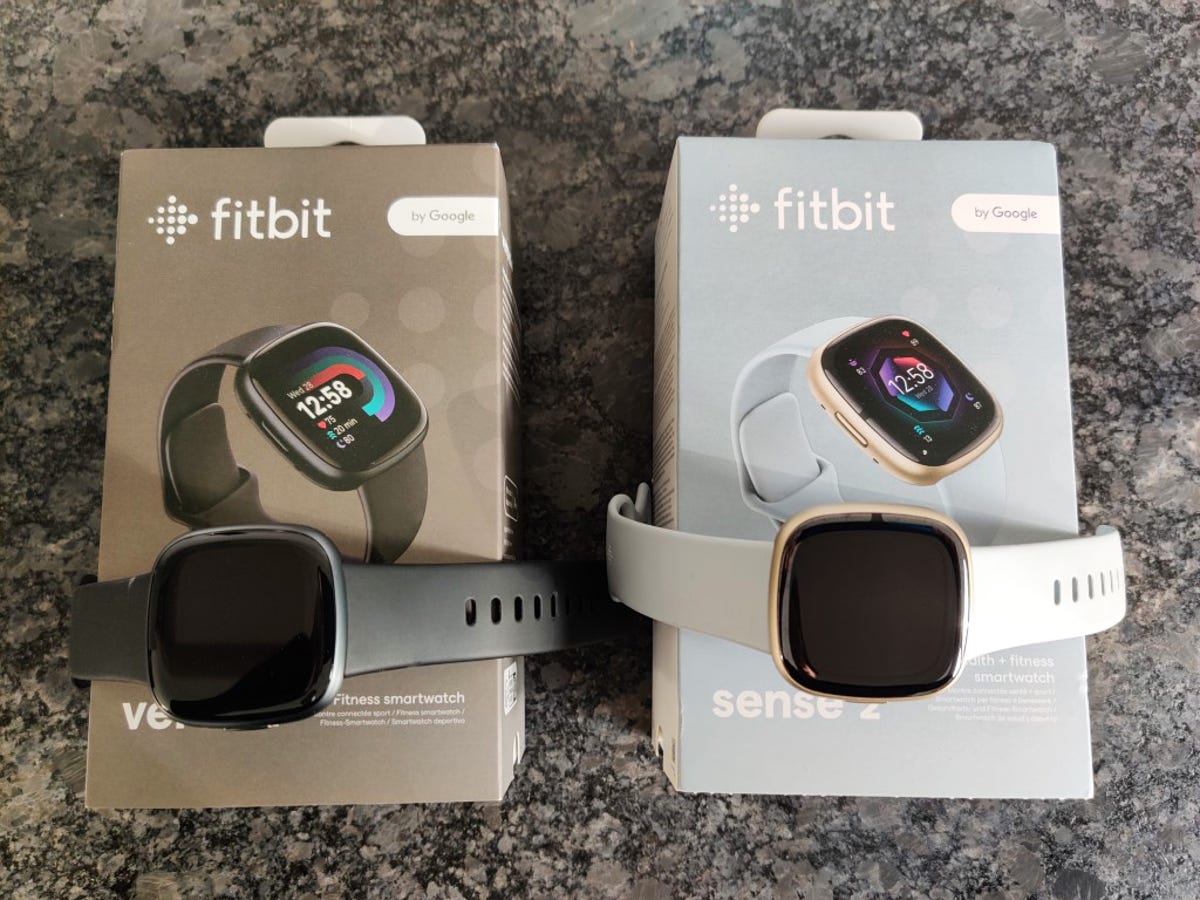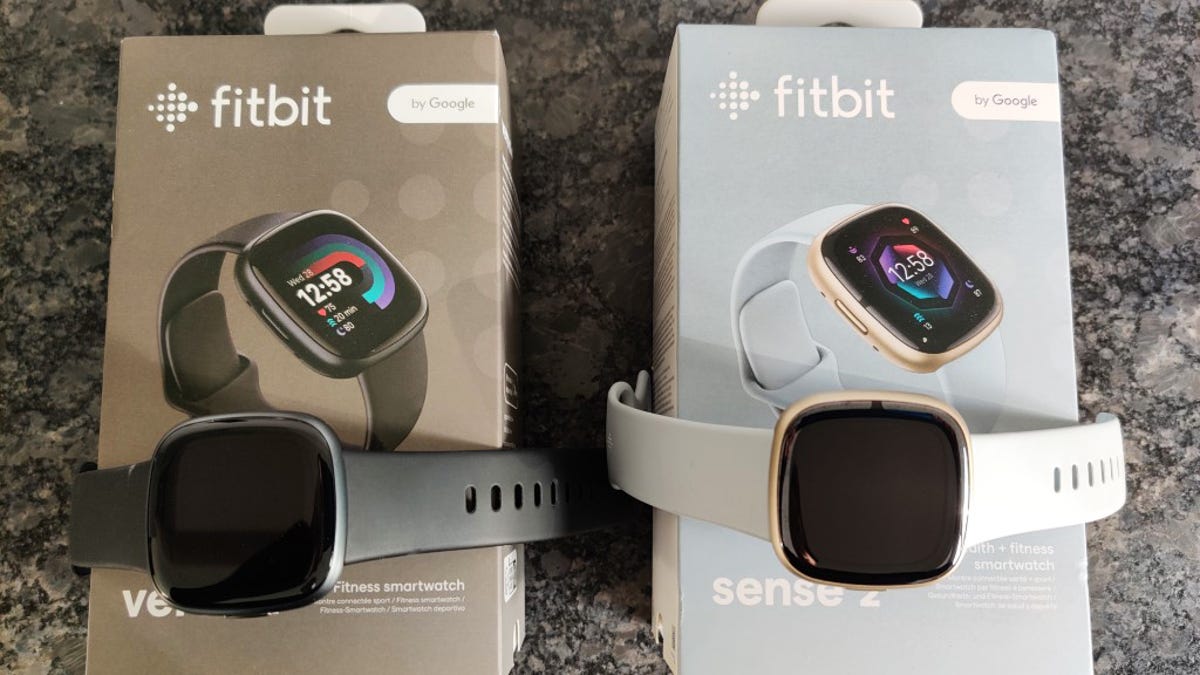A month with Fitbit’s Sense 2 and Versa 4: Good health and fitness features but beware GPS use

Fitbit pulled an interesting trick in August when it launched two smartwatches at the same time. The Fitbit Sense 2 and Versa 4 look very similar at first glance, yet they are rather different in price: the Sense 2 costs $299.95 (although it’s currently $100 off), while the Versa 4 costs £229.95. The Sense 2 has a couple of additional features, but does it really outshine the Versa 4?
As with all such questions, the answer really depends on what you’re looking for. I’ve been using both smartwatches for about a month, so here’s a comparison. You should also check out Matthew Miller’s review of the Fitbit Sense 2.
Fitbit Sense 2 & Versa 4 specifications
| Fitbit Sense 2 | Fitbit Versa 4 | |
| Operating system | Fitbit OS | Fitbit OS |
| Dimensions | 1.5in. x 1.5in. x 0.45in. | 1.5in. x 1.5in. x 0.45in. |
| Band size | small (5.5in.-7.1in. wrists) • large (7.1in.-8.7in. wrists) | small (5.5in.-7.1in. wrists) • large (7.1in.-8.7in. wrists) |
| Operating temperature | -14° to 113°F | -14° to 113°F |
| Water resistance | water resistant to 50m | water resistant to 50m |
| Display | colour OLED touch-screen | colour OLED touch-screen |
| Memory | 7 days of detailed motion data, daily totals for last 30 days • heart rate data: 5s intervals (1s during exercise) | 7 days of detailed motion data, daily totals for last 30 days • heart rate data: 5s intervals (1s during exercise) |
| Smartphone compatibility | iOS 14 or higher, Android 8 or higher | iOS 14 or higher, Android 8 or higher |
| Wi-Fi | built-in but disabled (cannot be turned on) | built-in but disabled (cannot be turned on) |
| Bluetooth | 5.0 | 5.0 |
| NFC | yes | yes |
| Location | GPS + GLONASS | GPS + GLONASS |
| Microphone | yes | yes |
| Speaker | 75dB SPL @10cm | 75dB SPL @10cm |
| Vibration motor | yes | yes |
| Sensors | multi-path optical heart rate sensor • cEDA sensor for body response tracking • multipurpose ECG/EDA sensors • red & IR SpO2 sensors • gyroscope • altimeter • 3-axis accelerometer • skin temperature sensor • ambient light sensor | multi-path optical heart rate sensor • red & IR SpO2 sensors • gyroscope • altimeter • 3-axis accelerometer • ambient light sensor |
| Battery | Lithium polymer | Lithium polymer |
| Battery life | 6+ days (up to 5 hours with continuous GPS) | 6+ days (up to 5 hours with continuous GPS) |
| Charge time | 0-100% in 2 hours | 0-100% in 2 hours |
| In the box | Fitbit Sense 2, classic band (small & large), charging cable | Fitbit Versa 4, classic band (small & large), charging cable |
| Price | $299.95 (currently on offer at $199.95) | $229.95 |
Starting off with general looks and design, there’s not a lot to differentiate the two devices. The Sense 2 has three different colour options — a Blue Mist band with Soft Gold Aluminium watch surround, plus Lunar White/Platinum Aluminum and Shadow Grey/Graphite Aluminum.
The Versa 4 has more colour options and a bit more vibrancy, with four strap/watch surround combos: Black/Graphite Aluminum, Waterfall Blue/Platinum Aluminum, Pink Sand strap/Copper Rose Aluminum and Beet Juice/Copper Rose Aluminum.
Both watches are the same size, measuring 40.5mm by 40.5mm by 12.3mm, and are square with rounded-off corners. They sport a responsive full colour touchscreen and, on the solid aluminium surround, a touch-sensitive button. Both watches have a heart rate sensor on the underside and although Fitbit doesn’t use IP ratings, the company says that both devices are water resistant up to a depth of 50m.
Neither watch felt heavy on my relatively small wrist and both share the same silicone band design, coming in two band sizes. The fixing is solid and never felt anywhere near coming apart. In the physical aspects of their design, then, there’s nothing to differentiate the two apart from variations in colour schemes.
What about features? Well, there’s a lot of similarity here too. The full list of capabilities is too long to recount in full but includes all the necessary smartwatch basics. You get heart rate monitoring, active zone features, the ability to automatically recognise some forms of exercise, count steps and floors climbed, estimate calories burned, calculate distance travelled, and provide sleep and heart rate metrics. Both devices can notify owners of an irregular heart rhythm, monitor blood oxygen (SpO2), and come with six months of Fitibit Premium subscription.
There is plenty of smartphone integration including call, text and app notifications, and a wide range of clock faces for personalisation. Both watches also feature Alexa but not Google Assistant or any Gmail or Google calendar integration — even though Fitibit is now owned by Google. Perhaps Google wants to keep these features just for its own $349 Pixel Watch, although both the Sense 2 and Versa 4 are expected to offer support for Google Maps and Google Wallet before long.
The key areas of difference are that the more expensive Sense 2 has a handful of features the Versa 4 lacks. These include an ECG app, a skin temperature sensor and EDA scanning – a stress management feature.
The stress management feature ties in with Fitbit’s relatively recent focus on wellness. The EDA scanner uses skin temperature to ascertain stress levels, and delivers a stress management score visible in the Fitibit app, which allows you to get a sense of your stress levels over time. A daily score is given out of 100, and the part of the Fitbit app that provides this score also gives access to mindfulness activities. A Fitbit Premium subscription opens the full mindfulness range, with a subset available on the free Fitbit app. You can also, if so inclined, log your mood.
The ECG app keeps an eye on heart rate and allows heart rhythm assessments over time with an aim of identifying possible atrial fibrillation — irregular heart rhythm. Although it’s more granular than the basic notification that’s on both watches, the ECG app should only be seen as an indicator of heart health: if in doubt, seek an appointment with a medical professional.
When it comes to battery life there are again many similarities between the Sense 2 and Versa 4. In both cases the batteries are rated as good for ‘6+ days’, with some qualifications. The battery is only rated for up to 5 hours with continuous GPS, so anyone wanting to take long walks with full GPS will be disappointed. And if you use SpO2 and the cEDA app on the Sense 2, you’ll need to charge more frequently as these are also power-hungry features.
Both watches also support fast charging: according to Fitbit, 12 minutes of charging will deliver a day’s worth of battery. However, given the fact that a full day with GPS enabled is not possible, this must mean a day’s worth of battery without GPS.
Battery life on both devices was very similar in my experience. In general use, without using battery-sapping features and no GPS, I found the battery fell by about 15% a day, suggesting nearly a week in total. It regained that 15% in the time it took me to get ready for work in the morning. The charge unit for both devices is a small, portable magnetic square, with a USB-A connector at the charging end.
Both the Sense 2 and Versa 4 are nicely designed, comfortable to wear and have responsive touch screens. There are many similarities in both design and functionality, but given the current $100 discount, the Sense 2 with its extra features looks attractive if those capabilities appeal to you. There’s another factor to consider, though: if you’re likely to need more than around 5 hours of continuous GPS usage on a regular basis, then neither of these smartwatches may be suitable.
RECENT AND RELATED CONTENT
Fitbit’s Sense 2 gave me a glimpse of how the Google Pixel Watch will be
Google Pixel Watch review: Not the Apple Watch of Android (yet)
Pixel Watch announced: Google and Fitbit make it the best smartwatch for Android users
Fitbit Sense review: Advanced health and wellness tracking, GPS, and coaching
The top Fitbit devices: Versa, Ace, Charge, Inspire, and Sense compared
Read more reviews




